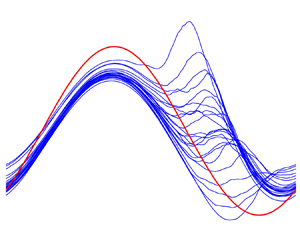No CrossRef data available.
Article contents
Time-delayed characteristics of turbulence in pulsatile pipe flow
Published online by Cambridge University Press: 11 January 2024
Abstract

Direct numerical simulations are performed to study temporal variations of the wall shear stresses and flow dynamics in the turbulent pulsatile pipe flow. The mechanisms, responsible for the paradoxical phenomenon for which the amplitude of the oscillating wall shear stress in the turbulent flow is smaller than that in the laminar flow for the same pulsation conditions, are investigated. It is shown that the delayed response of turbulence in the buffer layer generates a large magnitude of the radial gradient of the Reynolds shear stress near the wall, which counteracts the effect of the oscillating pressure gradient on the change of the streamwise velocity and hence reduces the amplitude of the wall shear stress. Such a delayed response consists of two processes: the delayed development of near-wall streaks and the subsequent energy redistribution from the streamwise velocity fluctuation to the other two co-existing components. This is a dynamical manifestation of the viscoelasticity of turbulent eddies. As the frequency is reduced, the variation of the friction Reynolds number results in a phase-wise variation of the time scale and intensity of the turbulence response, causing the hysteresis of the wall shear stress. Such a phase asymmetry is amplified by the increase of the pulsation amplitude. An examination of the energy spectra reveals that the near-wall streaks are stretched in the streamwise direction during the acceleration phase, and then break up into small-scale structures in the deceleration phase, accompanied by the enhanced dissipation that transforms the turbulent kinetic energy into heat.
JFM classification
- Type
- JFM Papers
- Information
- Copyright
- © The Author(s), 2024. Published by Cambridge University Press



